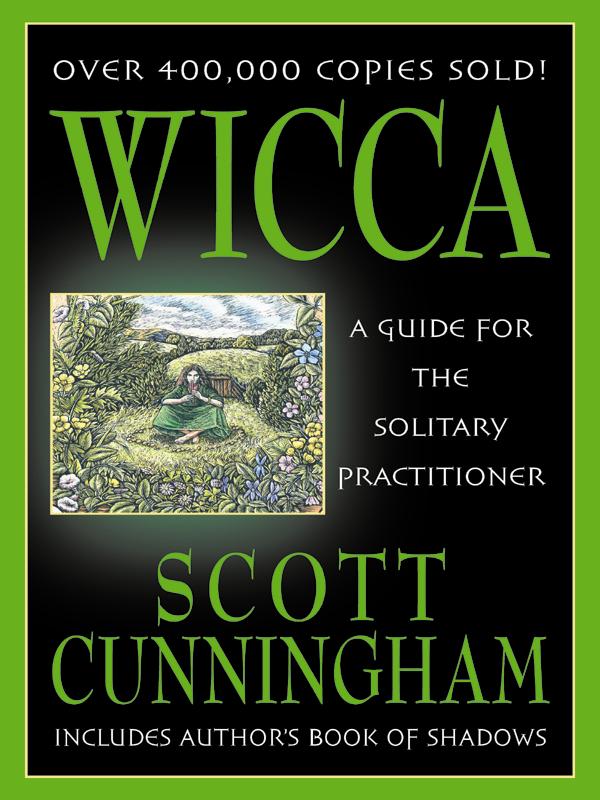Wicca


WICCA
About the Author
Scott Cunningham practiced elemental magic for over twenty years. He authored more than thirty books, both fiction and nonfiction. Scott’s books reflect a broad range of interests from the New Age sphere, where he was highly regarded. He passed from this life on March 28, 1993, after a long illness.
WICCA
A GUIDE FOR THE
SOLITARY PRACTITIONER
SCOTT
CUNNINGHAM

Llewellyn Publications
St. Paul,Minnesota
Wicca: A Guide For the Solitary Practitioner
© 2004 by Scott Cunningham. All rights reserved. No part of this book may be used or reproduced in any manner whatsoever, including Internet usage, without written permission from Llewellyn Publications except in the case of brief quotations embodied in critical articles and reviews.
As the purchaser of this e-book, you are granted the non-exclusive, non-transferable right to access and read the text of this ebook on screen. The text may not be otherwise reproduced, transmitted, downloaded, or recorded on any other storage device in any form or by any means.
Any unauthorized usage of the text without express written permission of the publisher is a violation of the author’s copyright and is illegal and punishable by law.
FIRST EDITION, REVISED
Thirty-seventh printing, 2005
First e-book edition © 2010
E-book ISBN: 9780738717159
Book design by Alexander Negrete and Kimberly Nightingale
Cover design by Anne Marie Garrison
Cover illustration © 2002 by Anthony Meadows
Interior illustrations by Kevin Brown
Revised edition edited by Kimberly Nightingale
Llewellyn Publications is an imprint of Llewellyn Worldwide Ltd.
Llewellyn Worldwide does not participate in, endorse, or have any authority or responsibility concerning private business transactions between our authors and the public.
Any Internet references contained in this work are current at publication time, but the publisher cannot guarantee that a specific location will continue to be maintained. Please refer to the publisher’s website for links to authors’ websites and other sources.
Llewellyn Publications
Llewellyn Worldwide, Ltd.
2143 Wooddale Drive, Dept. 0-87542-118-0
Woodbury, MN 55125,U.S.A.
www.llewellyn.com
Manufactured in the United States of America
This book is dedicated to the forces that watch over and guide us—
however we may envision or name them.
Acknowledgments
To deTraci Regula,Marilee, Juanita, and Mark and Kyri of the Silver Wheel for commenting on earlier drafts of the work.
To Morgan, Morgana, Abraham, Barda, and all those who have shared their knowledge and practices with me.
To all my friends at Llewellyn for their years of continuing support.
Contents
6. Ritual and Preparation for Ritual
7. The Magic Circle and the Altar
11. Exercises and Magical Techniques
Section III: The Standing Stones
Book of Shadows
Introduction to The Standing Stones Book of Shadows
An Herbal Grimoire: A Guide to the Use of Herbs and Plants in Wiccan Ritual
Appendix II: Wiccan and Pagan Publications
THIS BOOK, THE
result of sixteen years of practical experience and research, is a guidebook outlining basic Wiccan theory and practice. It is written with the solitary student or practitioner in mind; there are no coven rituals or magical group dynamics described herein.
The Wicca as described here is “new.” It is not a revelation of ancient rituals handed down for thousands of years. This does not invalidate it, however, for it is based on time-honored practices.
A three-thousand-year-old incantation to manna isn’t necessarily more powerful or effective than one improvised during a private rite.
The person practicing the ritual or spell determines its success.
If centuries-old incantations are nothing more to you than senseless gibberish, chances are the ritual won’t work, any more than would a Shinto ceremony in the hands of a Methodist. To be effective, rituals must speak to you.
Rituals are at the heart of Wicca for some, and are pleasant adjuncts to Wicca’s philosophy and way of life for others. In Wicca, as with every religion, ritual is a means of contacting the divine. Effective ritual unites the worshipper with deity. Ineffective ritual kills spirituality.
There are rituals in this book, yes, but they’re guideposts, not holy writ. I wrote them so that others, using them as general guidelines, could create their own.
Some people might say, “But that’s just your stuff. We want the
real
Wicca!
Tell us the secrets!”
There is not, and can never be, one “pure” or “true” or “genuine” form of Wicca. There are no central governing agencies, no physical leaders, no universally recognized prophets or messengers. Although specific, structured forms of Wicca certainly exist, they aren’t in agreement regarding ritual, symbolism, and theology. Because of this healthy individualism, no one ritual or philosophical system has emerged to consume the others.
Wicca is varied and multi-faceted. As in every religion, the Wiccan spiritual experience is one shared with deity alone. This book is simply one way, based on my experiences and the instruction I have received, to practice Wicca.
Although I wrote it, it didn’t hatch out of thin air. The jeweler who facets rough emeralds didn’t create the gemstones; nor the potter the clay. I’ve tried to present a blending of the major themes and ritual structures of Wicca, not to create a new form, but to present one so that others can develop their own Wiccan practices.
When I began learning Wicca there were few books, certainly no published Books of Shadows.
*
Wiccan rituals and magical texts are secret within many traditions of Wicca, and it wasn’t until recently that any systems have “gone public.” Due to this fact, few Wiccans wrote books describing the rituals and inner teachings of Wicca. Those outside the Wicca (or the Craft as it is also known) who wrote of it could necessarily report only garbled or incomplete pictures.
Within a few years of my introduction to Wicca, however, many authentic, informative books began to be published.As I continued my studies, both independently and under teachers I had met, I realized that anyone trying to learn and practice Wicca solely from published sources would gain a sadly unbalanced picture.
Most Wiccan authors tout their own form of Wicca. This makes sense: write what you know. Unfortunately, many of the foremost Wiccan authors share similar views, and so most of the published Wiccan material is repetitive.
Also, most of these books are geared toward coven-(group) oriented Wicca. This poses a problem for anyone unable to find a minimum of four or five interested, compatible persons to create a coven. It also lays a burden on those who desire private religious practice.
Perhaps my true reason for writing this book—besides numerous requests—is strictly personal. I not only wish to present an alternate to staid, structured Wiccan books, I also want to return something for the training I have received in this contemporary religion.
Although I occasionally teach, and Wicca always draws a crowd, I prefer the medium of printed words to point out some of the things I have learned. Although nothing can replace one-on-one teaching, this isn’t practical for all those desiring to learn.
And so, several years ago, I began jotting down notes and chapters that eventually became this book. To avoid becoming too narrow-minded (Sybil Leek once said that it was dangerous writing about your own religion—you’re too close to it), I’ve had Wiccan friends read and comment on early drafts to ensure that the picture of Wicca presented here isn’t too limited or dogmatic.
Please don’t misunderstand me. Though this book’s goal is a wider understanding of, and appreciation of Wicca, I’m not proselytizing. Like most Wiccans, I’m not out to change your spiritual and religious beliefs; it’s none of my business.
However, with the continuing interest in nontraditional religions, concern over environmental destruction, and a wide interest in the Wiccan religion, I hope this book partially answers one of the questions I’m most commonly asked: “What is Wicca?”
Linguistic Note
Much disagreement concerning the exact (and original) meaning of the word “Wicca” presently exists. It’s not my intention to enter into or add to such discussions, but I don’t feel that I can use this term without defining it. Therefore,“Wicca”will be used within this book to describe both the religion itself (a loosely organized pagan religion centering toward reverence for the creative forces of nature, usually symbolized by a goddess and a god), as well as its practitioners of both sexes. The term “Warlock,” though sometimes used to describe male practitioners, is virtually never used by Wiccans themselves; hence I’ve avoided it here. Though some use “Wicca” and “Witch” almost interchangeably, I prefer the older, less-encumbered word “Wicca,” and so use it almost exclusively.
*
See glossary for unfamiliar terms.
WICCA,
THE RELIGION
of the “Witches,” has long been shrouded in secrecy. Anyone interested in learning “the Craft” had to content themselves with hints from books and articles. The Wiccans wouldn’t say much, save that they weren’t looking for new members.
Growing numbers of people today are dissatisfied with traditional religious structures. Many are searching for a personally involving religion, one that celebrates both physical and spiritual realities, in which attunement with deity is coupled with the practice of magic.
Wicca is just such a religion, centering around reverence for nature as seen in the Goddess and the God. Its spiritual roots in antiquity, acceptance of magic, and mysterious nature have made it particularly appealing. Until recently, the lack of public information concerning Wicca and its apparent exclusivity has caused much frustration among interested students.
Wicca doesn’t seek new members. This has been a major stumbling block to those wishing to learn its rites and ways of magic. Wicca doesn’t solicit because, unlike most western religions, it doesn’t claim to be the one true way to deity.
With growing numbers interested in practicing Wicca, perhaps it’s time to allow the full light of the dawning Aquarian Age to illuminate these ways. To do so is not to trumpet Wicca as the salvation of our planet, but simply to present it to anyone who cares to learn.
There have been many obstacles. In the past the only way to enter Wicca was to a) contact an initiated Wicca, usually a coven member, and b) receive initiation. If you didn’t know any Witches you were out of luck, for initiation was an absolute prerequisite.
Today, times are changing. We are maturing, perhaps too quickly. Our technology outpaces the wisdom to utilize it. Vast unrest spreads over the globe, and the threat of war looms over most of the more than six billion persons alive today.